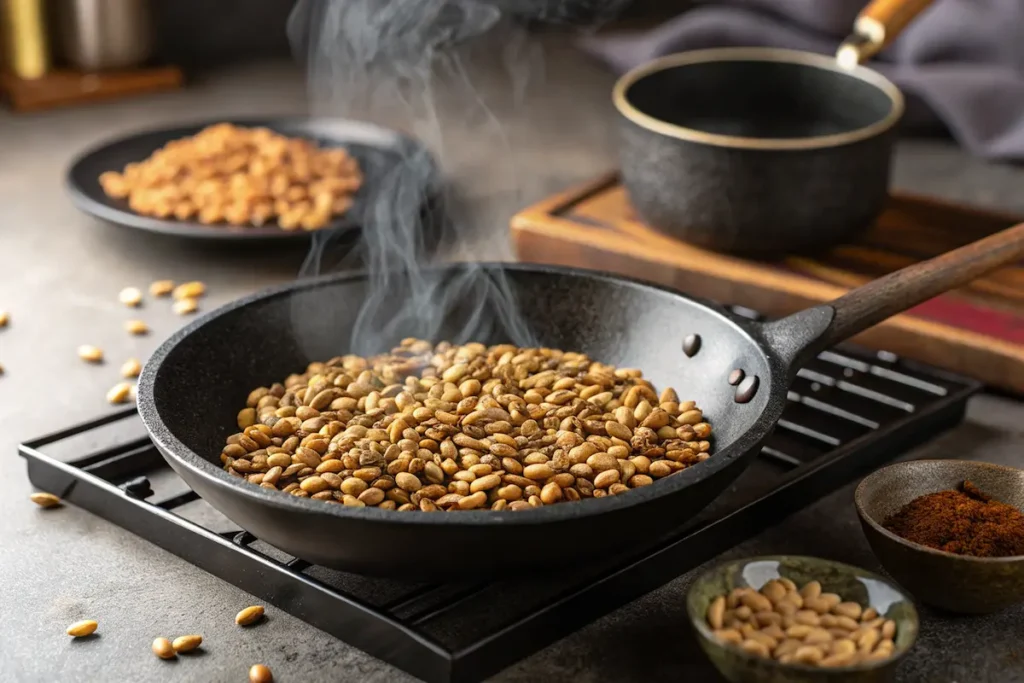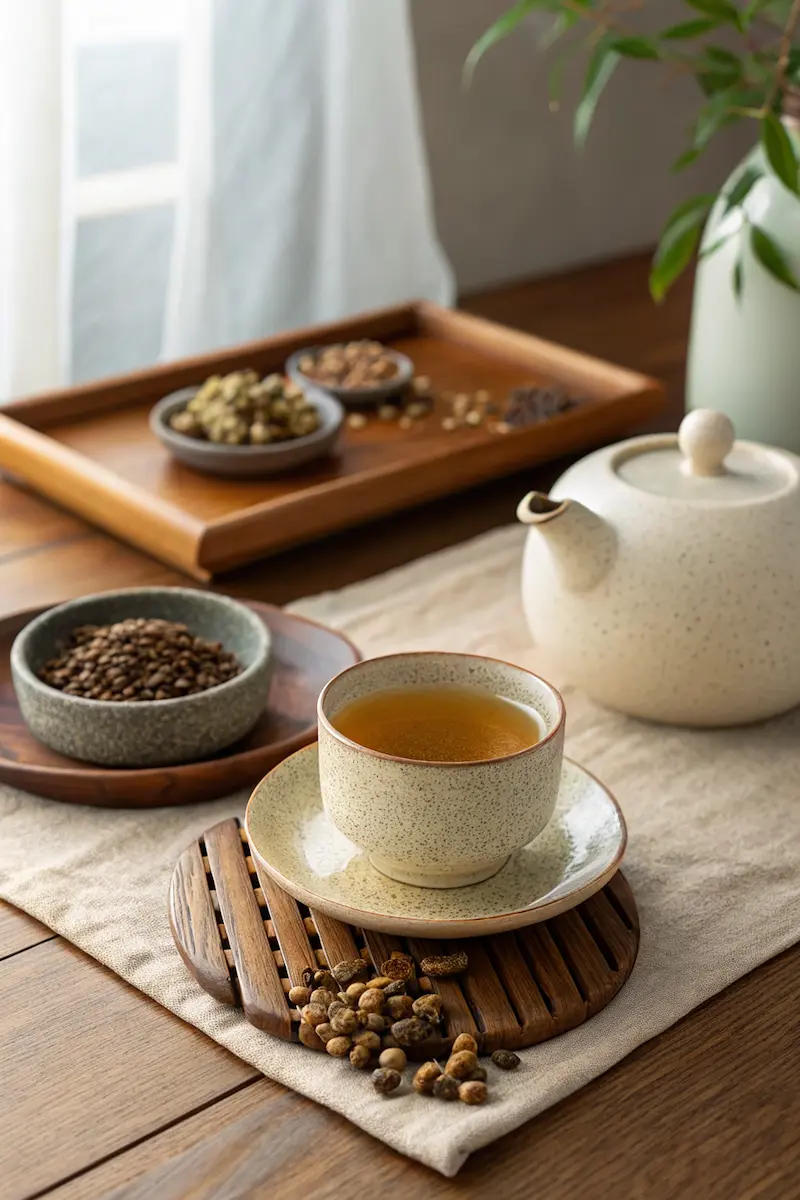Cassia seed tea Korean style is more than just a soothing drink—it’s a ritual, a remedy, and a reflection of generations of wellness tradition. In this article, I’ll guide you through its cultural roots, health perks, and how you can brew this golden infusion at home. You’ll also get insider tips and a printable recipe card to make it part of your daily calm.
Let’s begin with a memory that still warms my heart…
Table of Contents
A Korean Kitchen Memory and the Magic of Cassia
Remembering My First Cup: A Cozy Introduction to Cassia Seed Tea
Growing up, I remember my grandmother slowly roasting tiny, glossy brown seeds in a pan. The aroma that filled the house was toasty, nutty, and calming—like a warm blanket on a cold morning. That was my first introduction to cassia seed tea Korean style.
She handed me a cup after dinner, claiming it would help me sleep and “clear the eyes.” I didn’t question it. One sip, and I understood. The tea had a light bitterness, followed by a soft sweetness that lingered. It became our evening ritual.
Now, I pass this comfort to you—this tea that’s simple, wholesome, and deeply rooted in Korean culture. It’s not just about taste—it’s about nourishment and memory. Cassia seed tea Korean households swear by is something you’ll find on pantry shelves right next to barley and corn teas.
You can read more about roasted barley tea benefits or discover how eucalyptus tea benefits offer soothing support.
PrintCassia Seed Tea Korean Style: Benefits, Brewing, and Ancient Wellness
Cassia seed tea Korean style is more than just a soothing drink—it’s a ritual, a remedy, and a reflection of generations of wellness tradition. Rooted in Korean culture, it offers digestive support, eye health, and calming benefits.
- Prep Time: 5 minutes
- Cook Time: 7 minutes
- Total Time: 12 minutes
- Yield: 2 cups 1x
- Category: Beverage
- Method: Stovetop
- Cuisine: Korean
- Diet: Vegan
Ingredients
- 2 tablespoons of raw cassia seeds
- 2 cups filtered water
Instructions
- Roast the seeds in a dry pan over medium heat, stirring constantly, until they pop and smell toasty (about 5–7 minutes).
- Remove from heat and let cool.
- Add 1–2 teaspoons of roasted seeds per cup to a teapot or infuser.
- Pour hot water (not boiling) over the seeds and steep for 5–10 minutes.
- Strain and enjoy warm or chilled.
- Reuse the seeds once more for a milder second brew.
Notes
Sweeten naturally with jujube, honey, or rice syrup. Pair with light snacks like rice crackers, chestnuts, or mochi. Store roasted seeds in a glass jar in a cool, dark place.
Nutrition
- Serving Size: 1 cup
- Calories: 5
- Sugar: 0g
- Sodium: 0mg
- Fat: 0g
- Saturated Fat: 0g
- Unsaturated Fat: 0g
- Trans Fat: 0g
- Carbohydrates: 1g
- Fiber: 0g
- Protein: 0g
- Cholesterol: 0mg
Cassia Seed Tea Korean Tradition: A Tea With Generations of Healing
In Korea, cassia seeds—known as gyeolmyeongja—have been used for centuries in traditional herbal medicine. This caffeine-free tea is especially popular in autumn and winter, and families often roast large batches to store.
What makes cassia seed tea Korean homes favor so special is its dual function: it’s a daily health drink and a gentle detox. Unlike green tea or oolong, cassia seed tea is not about energy. It’s about calming the body, cleansing the system, and inviting rest.
Whether you sip it during quiet mornings or after meals to aid digestion, this tea brings both comfort and purpose to your routine.
If you’re seeking other traditional infusions, try our white pine needle tea benefits or brew your own butterfly pea flower tea at home.
What Is Korean Cassia Seed Tea?
What Are Cassia Seeds and Why They Matter: Understanding the Source
Cassia seeds come from the Cassia obtusifolia or Senna obtusifolia plant. These shiny seeds are not the same as cinnamon cassia. Instead, they’re legume seeds known for their therapeutic effects in Traditional Chinese and Korean medicine.
They’re often roasted to reduce bitterness and release earthy oils. The roasted version is what’s used to make cassia seed tea Korean style. Once brewed, the tea has a mild roasted flavor, slightly bitter but with a comforting finish.
These tiny seeds are packed with:
- Anthraquinones, which support digestion
- Flavonoids, known for their anti-inflammatory effects
- Natural laxatives that gently cleanse the colon
You’ll also find them used in tea blends with chrysanthemum or licorice root, as seen in some Korean herbal shops.
How Korean Cassia Differs From Other Versions: Unique Flavors & Preparation
Unlike Chinese medicinal decoctions, Korean cassia seed tea emphasizes simplicity and drinkability. Koreans usually dry-roast the seeds until fragrant and steep them with hot water—no boiling required.
Some Korean recipes blend roasted cassia with barley or corn to round out the flavor. Others sweeten the tea with jujube slices, honey, or even rice syrup.
For a soothing alternative, you might want to try this natural mounjaro recipe designed for gut wellness.
Health Benefits of Korean Cassia Seed Tea
Digestive and Eye Health: Traditional Beliefs and Modern Support
Cassia seed tea has long been praised for cleansing the liver, aiding digestion, and soothing the eyes. In traditional Korean medicine, it’s often recommended for people who:
- Have dry or itchy eyes from screen use
- Struggle with sluggish digestion
- Need help falling asleep due to stress
Studies support its use for constipation relief and ocular health, thanks to the presence of emodin and rhein, two compounds that help regulate bowel movement and reduce inflammation.
Drink it alongside fiber-rich meals or support your gut further by learning what mounjaro does to your gut with natural options.
Weight Loss and Sleep Aid Claims: What Science and Grandmas Say
While it’s not a miracle tea, cassia seed tea Korean-style is often part of weight control regimens. Why? Because it:
- Helps eliminate waste gently
- Reduces water retention
- Curbs late-night snacking by relaxing the body
Some studies have linked cassia seed intake to reduced lipid levels in the liver and mild sedative effects.
Pair it with drinks to weight loss that support your goals naturally—no crash diets required.

How to Make Korean Cassia Seed Tea at Home
Roasting, Brewing, and Steeping Times: Step-by-Step Guide
Ingredients:
- 2 tablespoons of raw cassia seeds
- 2 cups filtered water
Instructions:
- Roast the seeds in a dry pan over medium heat, stirring constantly, until they pop and smell toasty (about 5–7 minutes).
- Remove from heat and let cool.
- Add 1–2 teaspoons of roasted seeds per cup to a teapot or infuser.
- Pour hot water (not boiling) over the seeds and steep for 5–10 minutes.
- Strain and enjoy warm or chilled.
You can reuse the seeds once more for a milder second brew.
Need more gentle drinks? Learn how to drink matcha while pregnant safely or sip on a lighter option like butterfly pea.
Best Tips and Variations: Pairings, Sweeteners, and When to Drink It
- Sweeten naturally with jujube, honey, or rice syrup
- Pair with: light snacks like rice crackers, chestnuts, or mochi
- When to drink: after dinner, before bed, or between meals
- Best storage: keep roasted seeds in a glass jar in a cool, dark place
Cassia blends beautifully with flowers too. Try combining it with iced butterfly pea flower tea latte for a color-changing experience.
FAQ
1. What is Cassia seed tea good for?
Cassia seed tea Korean households rely on is commonly used to support digestion, ease constipation, reduce eye fatigue, and promote better sleep. Its natural compounds like emodin and rhein are known to support liver cleansing and mild detoxification. It’s especially helpful after heavy meals or before bedtime.
2. What is cassia seed in Korean?
Cassia seed is called “gyeolmyeongja” (결명자) in Korean. It’s a staple ingredient in traditional teas and holistic remedies across Korea, often found in dried form and roasted before brewing. Gyeolmyeongja-cha (결명자차) refers specifically to cassia seed tea Korean style.
3. What are the side effects of cassia seed tea?
Although cassia seed tea is generally safe, overconsumption may lead to loose stools, dehydration, or stomach cramping due to its mild laxative properties. People with low blood pressure or those on diuretics should consult a doctor before regular use. Always drink in moderation.
4. How often should I drink Cassia seed tea?
For most people, 1 to 2 cups per day of cassia seed tea Korean style is considered safe and beneficial. It’s best to drink it after meals or in the evening to aid digestion and promote relaxation. Avoid excessive use, especially if you’re sensitive to herbal teas.
Conclusion
Now that you know how to roast, brew, and enjoy it, why not make it part of your weekly ritual? Cassia seed tea Korean style brings both comfort and tradition to your cup—just remember to sip mindfully. Always enjoy herbal teas in moderation, and consult your doctor if you have any medical conditions or are taking medications.
Explore more natural wellness and comfort recipes at joyfulbiterecipes.com every week.


